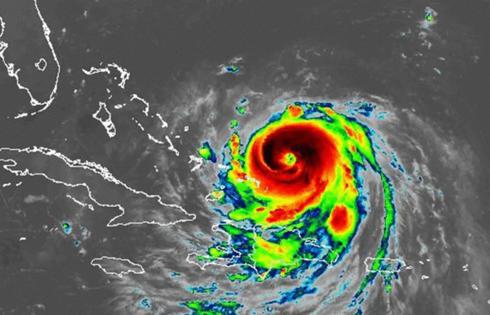Hurricane Erin intensifies near Bahamas with 2nd system coming up behind
Published in News & Features
ORLANDO, Fla. — Hurricane Erin on Monday bulked back up as a major Category 4 storm with an increasing wind field as it moved near the Bahamas. Meanwhile, the National Hurricane Center increased the odds a system following in the Atlantic could become the season’s next tropical depression or storm.
As of the NHC’s 11 a.m. advisory, the center of Erin was located about 110 miles north of Grand Turk Island and 880 miles south-southeast of Cape Hatteras, North Carolina moving west-northwest at 10 mph with maximum sustained winds of 140 mph, making it a strong Category 4 hurricane. It had fallen to a Category 3 hurricane with 125 mph most of Sunday.
“A turn to the northwest is expected later today, followed by a turn to the north and on Tuesday,” said NHC senior hurricane specialist Richard Pasch. “On the forecast track, the core of Erin is expected to pass to the east of the southeastern Bahamas today and move between Bermuda and the east coast of the United States by the middle of the week.”
Topical storm warnings remain in place for the Turks and Caicos and the southeast Bahamas while a tropical storm watch was issued for the central Bahamas. The NHC noted interests in the northwestern Bahamas, North Carolina Outer Banks and Bermuda should monitor the progress of Erin.
The path has shifted a little more west since Sunday and that could mean a bigger chance for dangerous conditions could affect the U.S. coast this week.
The storm became the season’s first hurricane at 11 a.m. Friday, with 75 mph winds, but grew to a “catastrophic” Category 5 hurricane in just one day undergoing rapid intensification that had sustained winds of up to 160 mph. It began to lose intensity late Saturday after pushing just north of the northern Leeward Islands.
“Given Erin’s impressive deep convection and strong upper-level outflow, it is expected to strengthen some more by later today,” Pasch said. “The system is expected to remain a major hurricane through the middle of this week.”
The system’s wind field began to expand on Sunday.
On Monday, that grew further with hurricane-force winds extending out 80 miles while tropical-storm-force winds extend out 230 miles.
“Erin’s expanding wind field will result in rough ocean conditions over much of the western Atlantic,” Pasch said.
Outer bands will continue to lash Hispaniola through Monday and the Turks and Caicos and parts of the southeast and central Bahamas through Tuesday with 2-4 inches of rain, but with some places getting up to 6 inches.
The system passed by the Cape Verde Islands earlier in the week, causing flash floods blamed for at least nine deaths.
The swells from the storm with dangerous surf and rip currents have spread to the Bahamas and will begin to affect Florida and rest of the U.S. East Coast, Bermuda and Atlantic Canada as the storm surges up into the Atlantic.
The NHC stated that waves could hit 50 feet heights as the center of the storm sits between the Outer Banks and Bermuda, and those kicked up conditions, and the track has moved a little closer to the U.S. coast.
“The forecast cone continues to take the storm east of Florida, but coastal impacts are forecast,” the National Weather Service in Melbourne stated. “Deteriorating surf, rip current, and boating conditions will reach our coast starting Monday and will peak Tuesday-Thursday.”
Of growing concern is a tropical wave following on the heels of Hurricane Erin.
As of the NHC’s 8 a.m. tropical advisory, the system had disorganized showers and thunderstorms moving toward the central Atlantic.
“Environmental conditions appear conducive for gradual development of this system, and a tropical depression could form during the latter part of the week,” forecasters said. “This system should move westward to west-northwestward at about 20 mph across the central tropical Atlantic and approach the vicinity of the Leeward Islands toward the end of the week.”
The NHC gave it a 50% chance to develop in the next seven days.
If it were to form into a named storm, it could become Tropical Storm Fernand.
The National Oceanic and Atmospheric Administration recently updated its season forecast, now calling for 13-18 named storms for the year, of which five to nine would grow into hurricanes. Two to five of those would develop into major hurricanes of Category 3 strength or higher.
The height of hurricane season runs from mid-August into October while the entire six-month season runs June 1 to Nov. 30.
-------------
©2025 Orlando Sentinel. Visit at orlandosentinel.com. Distributed by Tribune Content Agency, LLC.







Comments